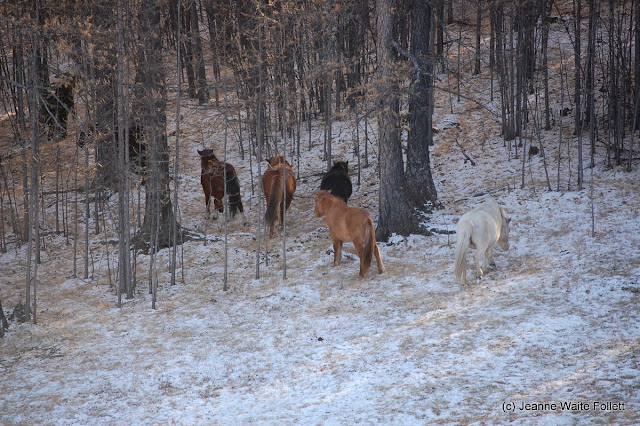Those guys killed fifteen sheep and a horse last night, says one of
the nomad herders sitting on the floor of a warm and comfortable ger. He is drinking tea and eating aaruul, dried curdled milk curds.
 |
| Batdorj at left, the daughter, and Lhagvadorj at right. They are drinking salted yak milk tea from small bowls. |
I’m quite certain there are only two people in that ger who don’t know what those guys means. One of them is me. I don’t understand because I don’t speak Mongolian. The other is a little girl who probably isn’t paying attention to her father and uncle because she is fixated on the gray-haired, blue-eyed, white-skinned apparition that has appeared in her home.
The others know—the two
brothers (one of whom is the speaker), the woman of the house, my guide Yusef
and driver Chimdee. In other countries,
in other cultures, that one and those guys are wolves. In this culture, the Mongolian name for wolf
is not spoken for fear of summoning the predator. This is a Shamanistic culture wherein spirits
are powerful and respected and treated with caution.
The two men are seated on colorful carpets spread on the ground near a small stove that is centered in the round ger, its stovepipe exiting through the center of the roof. Today it holds burning wood, but dried dung is also used. There is a plentiful supply of wood in the larch forest surrounding their home, and an even more plentiful and ever-replenishing supply of dung drying on the ground in the grazing lands that seem to extend forever in this northern part of Mongolia.
The tea is salted yak
milk tea, rich and delicious.
The salt cannot be tasted but seems to add some body to the
beverage. The dried milk curds resemble the
cakes of Salvo detergent sold decades ago, along with smaller pieces and scraps. When I am offered the basket, I select the
tiniest, thinnest piece I can find. I
immediately compare it (to myself) to what I think chewing on sheet rock would
be like—hard and gritty, and way too hard for my teeth.
 |
| Aaruul, dried curdled milk curds. |
Yusef says they dunk the dried curd into their tea to soften it, or suck on it. Packed with vitamins, aaruul has a somewhat sweet and somewhat sour taste. It makes an excellent trail snack.
The men are preparing to hunt
those ones. The wolves know the men will not take the
carcasses for food and thus the predators have plenty to eat for the
foreseeable future. Already, large
black vultures are lofting their way north along the mountain peaks and crags,
presumably towards the dead animals.
Outside, where the horses
are penned in a log khoroo (corral),
a single horse is tied up. It shies from
me to the extent of its tether, this foreign creature dressed in foreign
clothing. The herders are wearing the
traditional clothing of Mongolians—a warm woolen robe called a deel, bound at the waist with a sash, that
extends to mid-shin, and leather boots that reach beyond the bottom of the deel.
Yusef offers them a cigarette from his pack and the nomads enjoy the commercially rolled tobacco. Usually, they roll their own. Lhagvadorj selects a white horse for his brother from the herd. Once it is secured to the corral rail, all the horses are let loose.
The loosed horses head immediately to my right, down a small swale and into the forest of Siberian larch where the snow cover is less. In the sunlight streaming through the almost bare trees, the horses are like ghosts as they disappear into the Siberian larch forest.
Batdorj and his brother Lhagvadorj mount their horses, turn left, and set off up the valley to hunt and kill those ones.




















You HAVE GOT ME! Did you shoot this post while on your three day tour out of Ulaanbaatar at the beginning of our trip? Or did you shoot this post while Patti and I stayed the day at the lake up in the North and you went on out to see the waterfalls? Now IF I had to place a bet my money would be on the first guess. I say this because of the number of horses in the post and I know that you saw a lot of horses when you were in the National Park that Patti and I missed on our two day (as opposed to your three day) tour that included the 13th Century Ger Camps and the Genghis Khan Memorial. Patti and I are having a discussion about his name. Ghenggis Khaan is her version. Am I losing it or am I losing it. Anyway .. great post and excellent photos. Cap and Patti .. My brain is out to lunch here in the tropics of Goa in Arambol Beach.
ReplyDeleteYES YES AND YES .. Yes indeed it was the day in the North at the lake when Patti and I stayed in camp and you took off for the waterfall viewing. From your post about the road and the day in general Patti and I made the right decision (for us at least) to stay in camp. Great coverage and great post. YOU on the other hand made the absolute totally correct decision to see what you ended up seeing. Smiles from Cap and Patti ..
DeleteYes, on the aborted trip to the waterfall from Lake Khuvsgul. I'm trying to do these posts in a somewhat chronological order. I know you two have been online-time-deprived, so you missed much.
DeleteI bet you would have liked sitting atop one of the horses. Perhaps your bruised hip and the fact that you'd been atop a horse not long before this deterred you from asking for that privilege.
ReplyDeleteI felt I had already imposed on their time. They were going to be up against waning daylight if they waited much longer.
ReplyDelete